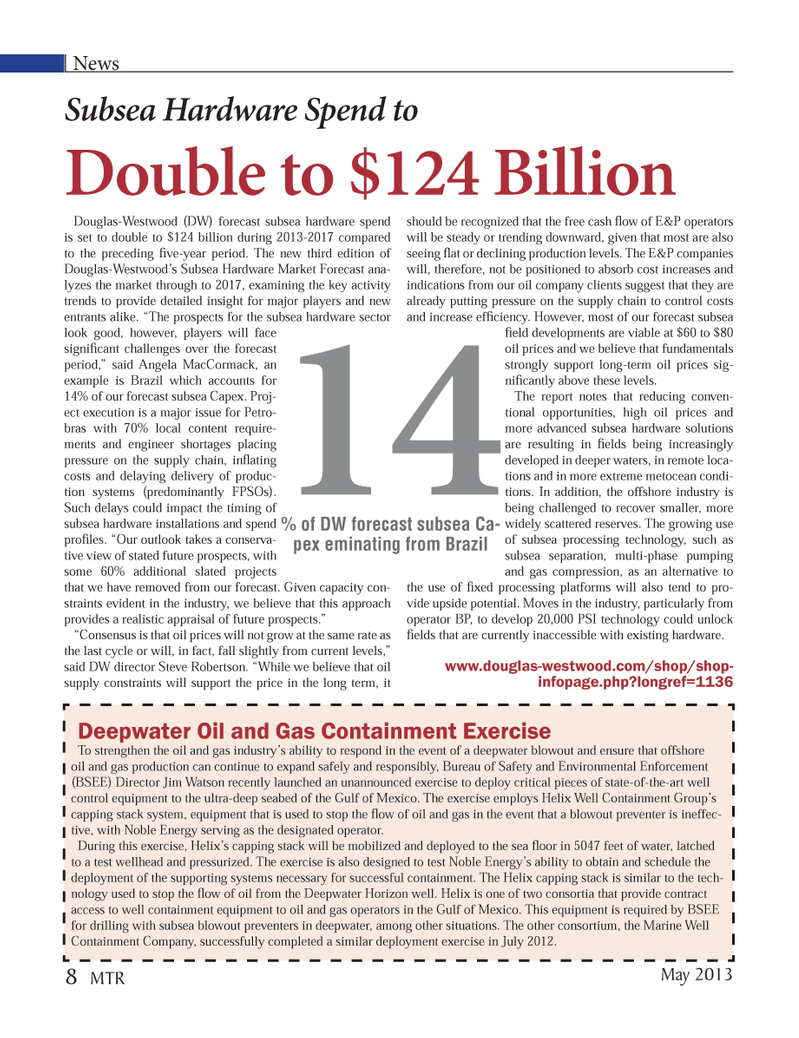
Page 8: of Marine Technology Magazine (May 2013)
Hydrographic Survey
Read this page in Pdf, Flash or Html5 edition of May 2013 Marine Technology Magazine
News Douglas-Westwood (DW) forecast subsea hardware spend is set to double to $124 billion during 2013-2017 compared to the preceding Þ ve-year period. The new third edition of Douglas-WestwoodÕs Subsea Hardware Market Forecast ana- lyzes the market through to 2017, examining the key activity trends to provide detailed insight for major players and new entrants alike. ÒThe prospects for the subsea hardware sector look good, however, players will face signiÞ cant challenges over the forecast period,Ó said Angela MacCormack, an example is Brazil which accounts for 14% of our forecast subsea Capex. Proj- ect execution is a major issue for Petro- bras with 70% local content require-ments and engineer shortages placing pressure on the supply chain, inß ating costs and delaying delivery of produc- tion systems (predominantly FPSOs). Such delays could impact the timing of subsea hardware installations and spend proÞ les. ÒOur outlook takes a conserva- tive view of stated future prospects, with some 60% additional slated projects that we have removed from our forecast. Given capacity con- straints evident in the industry, we believe that this approach provides a realistic appraisal of future prospects.Ó ÒConsensus is that oil prices will not grow at the same rate as the last cycle or will, in fact, fall slightly from current levels,Ó said DW director Steve Robertson. ÒWhile we believe that oil supply constraints will support the price in the long term, it should be recognized that the free cash ß ow of E&P operators will be steady or trending downward, given that most are also seeing ß at or declining production levels. The E&P companies will, therefore, not be positioned to absorb cost increases and indications from our oil company clients suggest that they are already putting pressure on the supply chain to control costs and increase efÞ ciency. However, most of our forecast subsea Þ eld developments are viable at $60 to $80 oil prices and we believe that fundamentals strongly support long-term oil prices sig-niÞ cantly above these levels. The report notes that reducing conven- tional opportunities, high oil prices and more advanced subsea hardware solutions are resulting in Þ elds being increasingly developed in deeper waters, in remote loca- tions and in more extreme metocean condi- tions. In addition, the offshore industry is being challenged to recover smaller, more widely scattered reserves. The growing use of subsea processing technology, such as subsea separation, multi-phase pumping and gas compression, as an alternative to the use of Þ xed processing platforms will also tend to pro- vide upside potential. Moves in the industry, particularly from operator BP, to develop 20,000 PSI technology could unlock Þ elds that are currently inaccessible with existing hardware. www.douglas-westwood.com/shop/shop- infopage.php?longref=1136 Subsea Hardware Spend to Double to $124 Billion Deepwater Oil and Gas Containment Exercise To strengthen the oil and gas industryÕs ability to respond in the event of a deepwater blowout and ensure that offshore oil and gas production can continue to expand safely and responsibly, Bureau of Safety and Environmental Enforcement (BSEE) Director Jim Watson recently launched an unannounced exercise to deploy critical pieces of state-of-the-art well control equipment to the ultra-deep seabed of the Gulf of Mexico. The exercise employs Helix Well Containment GroupÕs capping stack system, equipment that is used to stop the ß ow of oil and gas in the event that a blowout preventer is ineffec- tive, with Noble Energy serving as the designated operator. During this exercise, HelixÕs capping stack will be mobilized and deployed to the sea ß oor in 5047 feet of water, latched to a test wellhead and pressurized. The exercise is also designed to test Noble EnergyÕs ability to obtain and schedule the deployment of the supporting systems necessary for successful containment. The Helix capping stack is similar to the tech- nology used to stop the ß ow of oil from the Deepwater Horizon well. Helix is one of two consortia that provide contract access to well containment equipment to oil and gas operators in the Gulf of Mexico. This equipment is required by BSEE for drilling with subsea blowout preventers in deepwater, among other situations. The other consortium, the Marine Well Containment Company, successfully completed a similar deployment exercise in July 2012. 14% of DW forecast subsea Ca-pex eminating from BrazilMay 20138 MTRMTR #4 (1-17).indd 8MTR #4 (1-17).indd 85/6/2013 9:53:57 AM5/6/2013 9:53:57 AM

 7
7

 9
9
